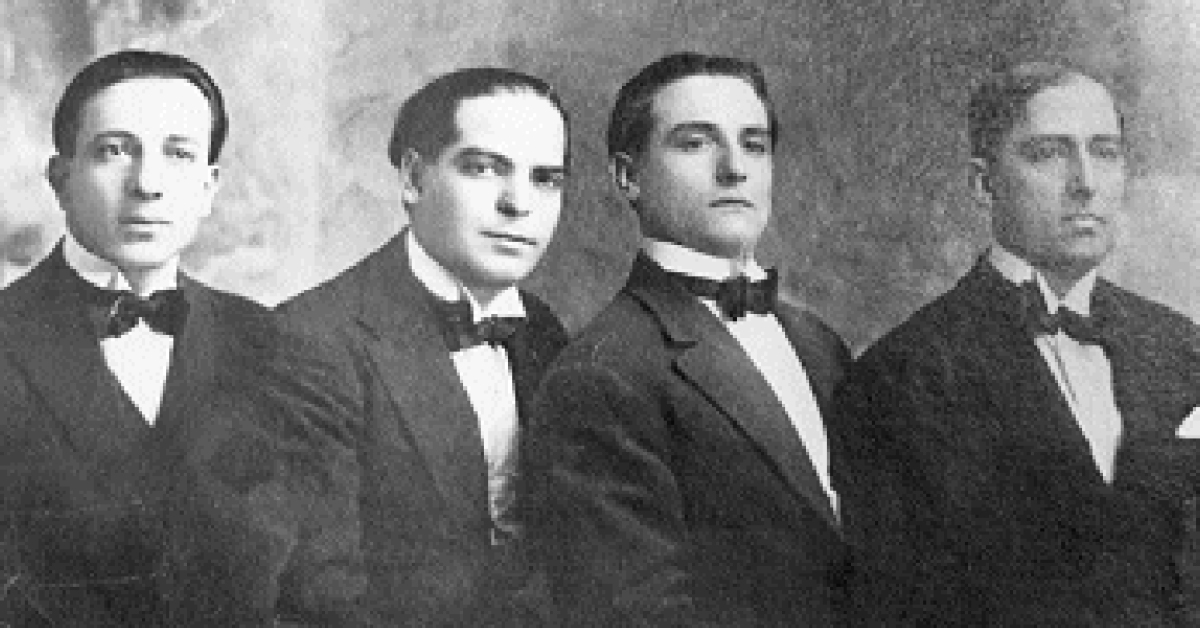
In 1909, when Eduardo Arolas composed “Una noche de garufa”, he had not yet acquired a formalized musical education.
He was 17 years old.
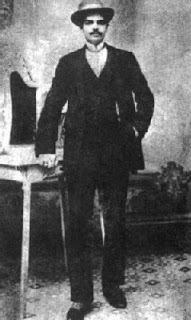
Still, in his first composition, all the elements of his style are present, bursting out into the world for the amusement of those who, like us, love Tango.
This quality cannot be attributed to any other Tango composer.
None of his colleagues had a defined style during their first compositions and would need many years to develop it. Arolas’ works have such advanced characteristics that they will keep forever surprising Tango lovers wondering how what inspiration and from which source Arolas extracted them.
He was born on February 24, 1892, in the nascent industrial neighborhood of Barracas, on the southern edge of Buenos Aires, where he grew up playing among workshops, construction sites, warehouses, deposits, workers, cart drivers, cuarteadores, payadores, and herdsmen.
At six years old, he started learning to play the guitar from his brother José Enrique.
Until 1906 he played this instrument with friends in informal settings and eventually began playing gigs at Cafés and Dancings in his neighborhood. Arolas was regarded as a skillful and versatile player.
He accompanied Ricardo González “Muchila”, who played the bandoneon. The sound of this instrument exerted a strong attraction on Arolas. He acquired a small one with 32 notes and began learning from Muchila.
After selling merchandise on the streets for many years, his parents opened a wholesale store and bar in front of the train station. Arolas, known as “el Pibe Eduardo”, and his brother played Waldteufel waltzes to entertain the clientele, which was very in vogue then.
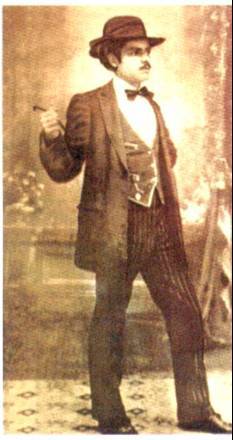 After finishing third grade, he quit school. He began working different jobs to help his family: busboy, delivery boy, apprentice at a print workshop, manufacturing of commercial signs, illustrator, decorator, and cartoonist, which became another of his passions, as seen in the drawings and artwork covers of his own published music compositions and for some colleagues.
After finishing third grade, he quit school. He began working different jobs to help his family: busboy, delivery boy, apprentice at a print workshop, manufacturing of commercial signs, illustrator, decorator, and cartoonist, which became another of his passions, as seen in the drawings and artwork covers of his own published music compositions and for some colleagues.On the record sheet of his neighborhood police station, he appeared classified as “compadrito”.
In 1909 he played a 42-button bandoneon, accompanied by Graciano De Leone on guitar.
That same year he presented his first composition to Francisco Canaro.
In 1910 he played with Tito Roccatagliatta, the most important violin player of that era; Leopoldo Thomson, who established the double bass in the orquestas típicas; and Prudencio Aragón, pianist and composer, author of “Siete palabras”.
In 1911, at 19 years old, he played in Montevideo for the first time, which would become his home when broken-hearted, he exiled himself voluntarily from Buenos Aires. At this gig, Arolas played a bandoneon of standard 71 buttons.
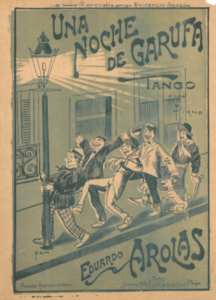 Upon his return from this trip, he started formal musical studies with José Bombig, conductor of the National Penitentiary band, who had a conservatory on Avenue Almirante Brown in La Boca neighborhood.
Upon his return from this trip, he started formal musical studies with José Bombig, conductor of the National Penitentiary band, who had a conservatory on Avenue Almirante Brown in La Boca neighborhood.During those three years at the conservatory, he made an extensive and profitable tour of the province's brothels with violinists Ernesto Zambonini and Rafael Tuegols.
While on this tour, he met Delia López, “La Chiquita”, and started a relationship that became a source of great inspiration for him and the likely trigger of the unfortunate choices that accelerated his demise.
Back in Buenos Aires, he mainly worked in his neighborhood of Barracas in various venues, including his own, “Una noche de garufa”, which he opened with his friend, the industrialist Luis Bettinelli.
His first composition, published in 1912, was an immediate great success.
Other compositions of remarkable inspiration followed, although they are not as well known today as they should be: “Nariz”, dedicated to his “amiguita” Delia López; “Rey de los bordoneos”, dedicated to his musicians; “Maturango”; “Chúmbale” and the vals “Notas del corazón”, dedicated to his mother.

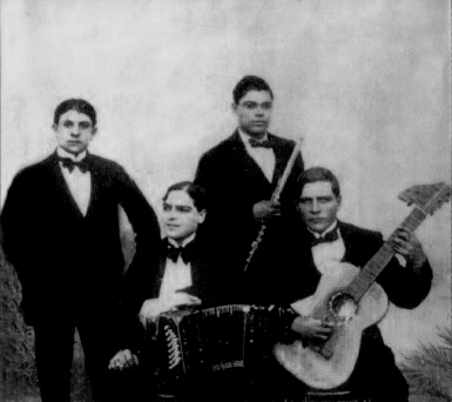
In 1910 the first recordings of an orchestra with the bandoneon, directed by Vicente Greco, were released by Columbia Records. The great acceptance by audiences of these recordings propitiated the appearance of numerous recording labels competing for the market. Arolas started recording in 1912 for Poli-phon, with Tito Roccatagliatta on violin, Vicente Pecci on flute, and Emilio Fernández on guitar.
In 1912 he started playing in downtown Buenos Aires and soon included in his formation the great pianist and composer José Martínez, author of “El cencerro”, “La torcacita”, “Pablo", “Punto y coma”, “Canaro”, among many great tangos, to play at the cabaret Royal Pigall, on Corrientes Street 825.
This same year, Roberto Firpo called Arolas and Roccatagliatta to play with him at the famous cabaret Armenonville. Later, Arolas distanced himself from Firpo and had a sign at his presentations that clarified, “We don’t play Firpo’s compositions”. But “Fuegos artificiales" became a great outcome from this encounter. Firpo still went on to record many of Arolas’ tangos.
Let's listen to the magnificent rendition of "Fuegos artificiales" by Anibal Troilo y su Orquesta Típica, 1945:
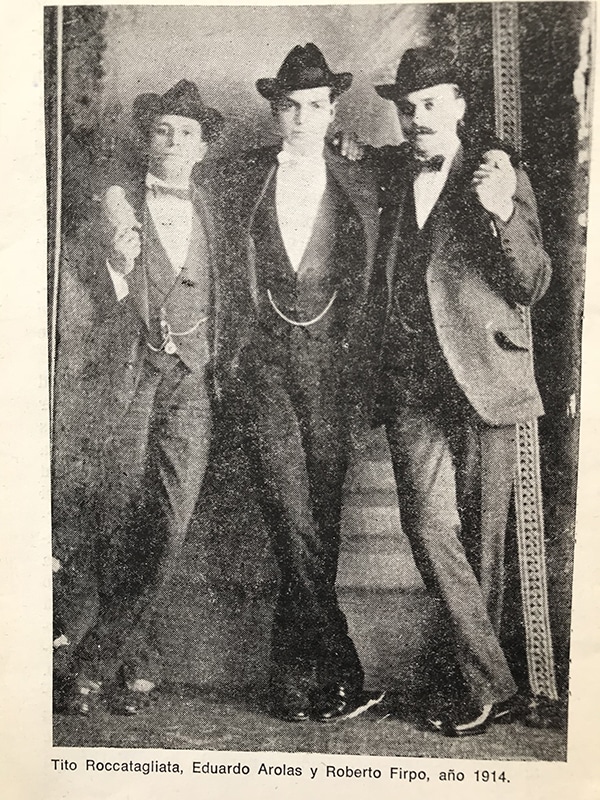
After taking distance from Firpo, in 1914, Afro-American Harold Philips played the piano for a while at Arolas' orchestra.
In 1915, Arolas played with Agustin Bardi on piano and Roccatagliatta on violin.
In 1916, he formed a trio with Roccatagliatta on violin and Juan Carlos Cobián on piano at the cabarets Montmartre, L’Abbaye, and Fritz, all located downtown. This trio sometimes expanded to a quartet to include a violoncello. They also made a tour of the province of Córdoba.
In Buenos Aires, the trio was hired to play at parties and dancings of the Buenos Aires’ upper-class mansions, embassies, and select clubs. At these kinds of gigs, any interaction between musicians and guests was not tolerated, a rule that Arolas never accepted, which resulted in his replacement by Osvaldo Fresedo.
Between 1913 and 1916, his musical composition and production showed evident improvement due to his musical studies and the achieved experience of his profession. He consolidated his fame, taking his orchestra to the level of the most prominent ones, leaving the neighborhood cafés, playing on Corrientes Street, and at the luxurious places of Palermo neighborhood, in the interior of Argentina, and in Montevideo.
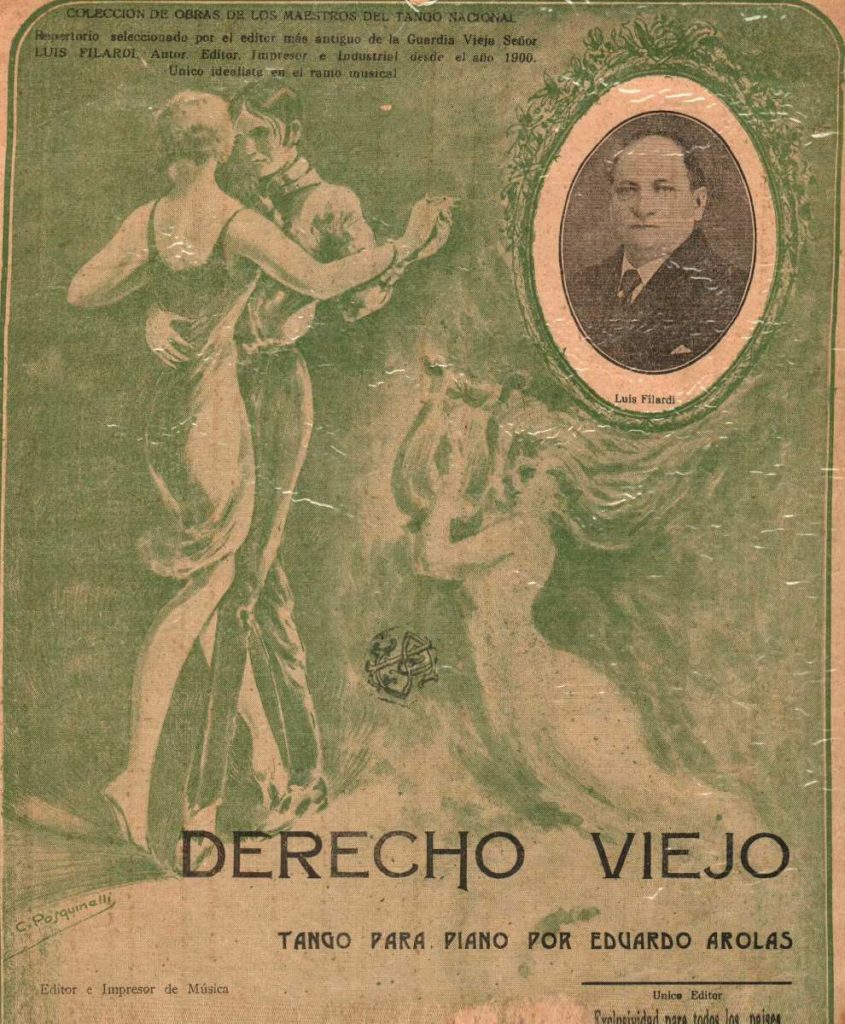
Some of the compositions of this period, among many that have today been forgotten, are “Derecho viejo”-played here by Osvaldo Pugliese y su Orquesta Típica in 1945:
“La guitarrita” -by Juan D'Arienzo in 1936:
“Rawson” -again, by El Rey del Compás:
“Araca” and “Anatomía”.

Specifically, regarding the song “Araca”, there is only one magnificent rendition recorded by “Cuarteto Victor de la Guardia Vieja” in 1936, with Francisco Pracánico on piano, Ciriaco Ortiz on bandoneon, and Cayetano Puglisi and Antonio Rossi on violins.
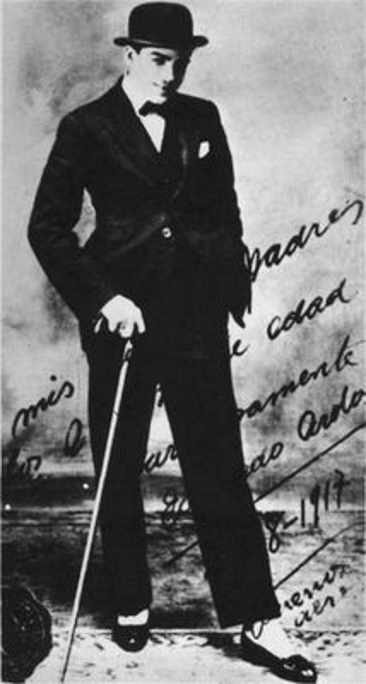
The third and last group of compositions, from 1917 to 1923, showed an even further musical evolution, deeper in feelings, nostalgic, almost crying with masculine vulnerability, playing with his characteristic rhythmic phrasing. These works were influenced by the break up with his lover Delia López, who ended up involved with his brother, and his subsequent submersion into alcoholism and chronic sadness. Among them: from 1917, “Comme il faut” -here is the recording of Anibal Troilo in 1938:
and “Retintin”, called first "Qué hacés, qué hacés, che Rafael!", dedicated to his violin player, friend and secretary, Rafael Tuegols. The whole orchestra sang the name of the song at the performances -here by Juan D'Arienzo y su Orquesta Típica, with Rodolfo Biagi on piano:
Less known from this same year are “Marrón glacé (Moñito)”, dedicated to the racing horse of his friend Emilio de Alvear; “El chañar”, of which there is a rendition by Alfredo De Angelis, recorded during the Golden Era:
and “Taquito”, recorded only by Arolas.
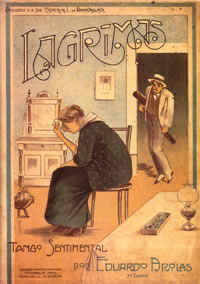 In 1917, he formed a quintet with Juan Luis Marini on piano, Rafael Tuegols, Atilio Lombardo on violins, and Alberto Paredes on violoncello and recorded for Victor with an advantageous contract. Unusual for the time, he included the voice of Francisco Nicolás Bianco, “Pancho Cueva”, on two recordings, only matched by the contemporary recording of Gardel-Razzano with Firpo at “El moro”. Bianco, who later also recorded with Firpo, was a famous payador who used the lunfardo jargon in his performances and was the brother of Eduardo Bianco. This great conductor played tangos in Europe.
In 1917, he formed a quintet with Juan Luis Marini on piano, Rafael Tuegols, Atilio Lombardo on violins, and Alberto Paredes on violoncello and recorded for Victor with an advantageous contract. Unusual for the time, he included the voice of Francisco Nicolás Bianco, “Pancho Cueva”, on two recordings, only matched by the contemporary recording of Gardel-Razzano with Firpo at “El moro”. Bianco, who later also recorded with Firpo, was a famous payador who used the lunfardo jargon in his performances and was the brother of Eduardo Bianco. This great conductor played tangos in Europe.The composition cover artwork for the song “Lágrimas” deserves a special mention because of Arolas' self-portrait:
Dedicated to the mother of his colleague and violinist Tito Roccatagliata, combined a delicious rhythmic first part with a profoundly emotional second part. Ricardo Tanturi recorded it in 1941:
In 1918 his orchestra was formed with him on the first bandoneon and conductor, Manuel Pizzarro on the second bandoneon, Rafael Tuegols on the first violin, Horacio Gomila on the second violin, Roberto Goyeneche on piano, and Luis Bernstein on double bass. This was the peak of his career, playing in both Buenos Aires and Montevideo. Soon, Julio De Caro joined his orchestra.
1918 brought us two tangos eminently rhythmic: “Catamarca”, initially called “Estocada a fondo”, of which Carlos Di Sarli left us a magnificent rendition in 1940:
The other tango is “Dinamita", which we can hear in the rendition of 1918 by Roberto Firpo:
Here we can appreciate authentic rhythmic dynamite, his peculiar way of playing with the melody, and its manifested advanced compositional techniques, using already the same “canyengueadas” that we hear in the arrangements of Osvaldo Pugliese and Astor Piazzolla many decades later.
That same year, Arolas met Pascual Contursi in Montevideo. From this encounter, they produced “Qué querés con esa cara”, lyrics that Contursi wrote for Arolas’ “La guitarrita”, recorded by Carlos Gardel:
This year culminated with one of his immortal compositions: “Maipo”, of supreme beauty, with a first part truly sublime, of pathetic depth, tearing, and the second part of felt sadness and deep emotions. Let’s dance to El Rey de Compás Juan D’Arienzo’s recording of this tango in 1939:
1919 began with no less than “El Marne”, a true concerto of advanced structure for its time. It needed to wait for qualified musicians to deliver the message of its notes. We remain here at the same tanda, with the Maestro D’Arienzo and Juan Polito on piano:
The productivity of Arolas is astounding. His fabulous inspiration keeps on giving: “Cosa papa”, which he only recorded on his last recording, in line with his best authorial achievements.
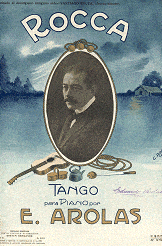 “Rocca”, dedicated to his great friend, the landowner, and keeper of Argentine traditions, Santiago H. Rocca, in which music sheet edition, we can see a portrait of the homaged, beautified by a fine drawing from Arolas.
“Rocca”, dedicated to his great friend, the landowner, and keeper of Argentine traditions, Santiago H. Rocca, in which music sheet edition, we can see a portrait of the homaged, beautified by a fine drawing from Arolas.There are no recordings that we know of this tango, but we are lucky to hear Horacio Asborno’s pianola playing it: https://youtu.be/oysQmH3QR3Q
“Viborita” is another of his delicate tangos, with the peculiarity of having only two parts, without a trio, as was his custom. Recorded in 1920 for the first time by the Orquesta Típica Select of Osvaldo Fresedo. Its music sheet was not published until after 1930, when the nephew of Arolas received a pack with manuscripts. That is why it appears published as posthumous work. A superb rendition of this tango to dance at the milongas is the one recorded by Francisco Lomuto in 1944:
“De vuelta y media”, of outstanding beauty, from which we are lucky to hear the author's recording:
And “El Gaucho Néstor”, included only in his recordings for Victor:
In 1919 he was hired to play at Montevideo’s Carnaval celebrations at the head of a big orchestra.
https://escuelatangoba.com/marcelosolis/history-of-tango-part-9-eduardo-arolas-the-evolution-of-tango-music/
No comments:
Post a Comment